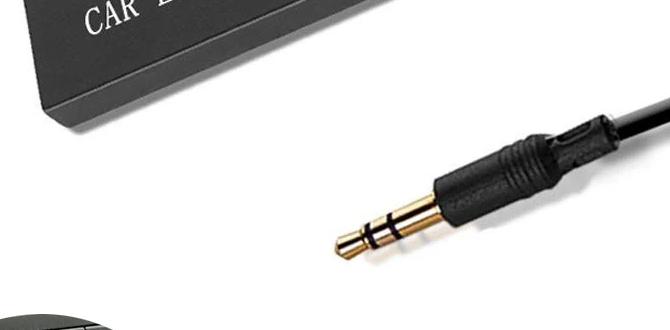Quick Summary: Testing parasitic draw prevents your car battery from draining unexpectedly. This easy guide shows you how to use a multimeter to find hidden electrical drains, saving you from dead batteries and costly repairs. Learn the simple steps to diagnose and fix the problem yourself.
Testing Parasitic Draw: Your Essential Guide to a Healthy Car Battery
Ever have your car refuse to start, even though your battery seemed fine yesterday? It’s a frustrating feeling, especially when you’re in a hurry. A common culprit for this “dead battery surprise” is something called a parasitic draw. Don’t let the word “parasitic” scare you; it just means a little bit of electricity is silently “leaking” from your battery even when your car is off. This guide will walk you through exactly how to find and fix these sneaky drains, making sure your car starts every time. You’ll be a battery detective in no time!
What Exactly is Parasitic Draw?
Imagine your car battery as a small fuel tank for your car’s electrical system. When the key is off, most of it should be resting, just holding its charge until you need it. A parasitic draw is like a tiny leak in that fuel tank. It’s a small amount of electrical current that continues to flow out of the battery even when the ignition is completely off and all the lights and accessories seem to be shut down. Most cars have a small, normal parasitic draw – just enough to keep things like the clock, radio presets, and alarm system active. However, if this draw becomes too large, it can drain your battery completely, leaving you stranded.
Why is Testing for Parasitic Draw Important?
Understanding and testing for parasitic draw is crucial for a few key reasons:
- Preventing Dead Batteries: The most obvious benefit is avoiding the annoyance and potential danger of a car that won’t start. A dead battery can happen at the worst possible moment.
- Extending Battery Life: Continuously draining a car battery, even a little bit more than normal, can shorten its lifespan significantly. Regular testing helps you catch problems before they cause permanent damage.
- Saving Money: By pinpointing the source of a parasitic draw, you can often fix it yourself or get a more precise repair estimate from a mechanic. This avoids unnecessary battery replacements or costly guesswork.
- Diagnosing Electrical Gremlins: Sometimes, a parasitic draw is a symptom of a larger electrical issue, like a faulty module or short circuit. Testing can help uncover these hidden problems.
How Much Parasitic Draw is Too Much?
This is a great question, and the answer can vary slightly between vehicles. However, a commonly accepted baseline for a “normal” parasitic draw on most passenger cars is between 20 and 50 milliamperes (mA).
To give you some perspective:
- 1 Ampere (A) = 1000 Milliamperes (mA)
- A small, normal draw (like for a clock or radio presets) might be around 25 mA.
- If you measure a draw of 50 mA or higher after the car has been off for a while (and settled down), it might be worth investigating further.
- A draw of 100 mA or more is almost certainly too high and likely to drain your battery overnight or within a couple of days.
Some high-end vehicles with many electronic features (like advanced security systems or remote start) might have a slightly higher acceptable “rest” draw, but excessive drain is always a problem.
Tools You’ll Need
Don’t worry, you don’t need a professional mechanic’s workshop to test for parasitic draw. With a few basic tools, you can do it yourself:
- Digital Multimeter: This is your most important tool. You’ll need one that can measure amperage (A or mA). Many multimeters can also measure voltage (V), which is helpful for battery health checks. Look for one with good reviews and a clear display. A reliable multimeter can be purchased for under $50. The Department of Energy’s Consumer Guide to Multimeters is a good resource for understanding how they work.
- Gloves: To protect your hands from battery terminals and grease.
- Safety Glasses: Always a good idea when working around car batteries.
- Basic Socket Set or Wrenches: To disconnect the battery terminals. You’ll likely need a 10mm or 13mm wrench, but it can vary by car model.
- Insulated Tools (Recommended): While not strictly necessary if you’re careful, using tools with insulated handles can add an extra layer of safety, especially when working near electrical components.
- A Helper (Optional): Having someone to assist can make the process smoother, but it’s not essential.
Preparing Your Car for the Test
Before you plug in that multimeter, some preparation is key to getting accurate results. The goal is to ensure your car’s electrical system has “gone to sleep.”
- Park Your Car: Find a safe, well-lit area to work.
- Turn Everything Off: Make sure all lights, radio, air conditioning, wipers, and any other accessories are turned off.
- Open the Hood: This gives you easy access to the battery.
- Let the Car Sleep: This is the most critical step for accurate readings. Modern cars have computers and modules that stay active for a while after the ignition is turned off. This “sleep mode” process can take anywhere from 15 minutes to an hour, or even longer for some vehicles. You’ll know it’s ready when the interior lights dim completely, and you don’t hear any more clicking or buzzing from the dashboard or under the hood. Don’t rush this step!
- Close the Doors: If you need to access the engine bay while testing, you might need to trick the car into thinking the doors are closed. Many cars have door jamb switches that turn on interior lights. You can often override this by:
- Manually engaging the door lock mechanism
- Using a small piece of tape over the door jamb switch
- Using a tool to depress the switch
The goal is to keep the interior lights and any related modules powered off while you work.
Step-by-Step: How to Test Parasitic Draw
Now for the main event! This process involves carefully disconnecting your battery and inserting the multimeter in a way that measures the current flowing out.
Step 1: Set Up Your Multimeter
- Turn your multimeter on.
- Set the dial to measure DC Amperage. You’ll typically choose a setting labeled “A DC” or “mA DC.” Start with the higher amperage setting (like 10A) on your multimeter. If you get no reading, you can switch to a lower setting (like 200mA) to get a more precise reading.
- Plug the black multimeter lead into the “COM” (common) port on your multimeter.
- Plug the red multimeter lead into the port for measuring amperage. This is usually labeled “A,” “mA,” or “10A.” Crucially, do NOT use the port labeled “V” (for voltage) or “Ω” (for resistance) when measuring amperage, or you could blow a fuse on your multimeter or even short something out!
Step 2: Disconnect the Battery Terminal
- Using your wrench or socket set, carefully loosen the nut on the negative (-) battery terminal.
- Gently twist and pull the negative cable off the battery post. Always disconnect the negative terminal first.
- For safety, tuck the negative cable away so it cannot accidentally touch the battery post or any metal part of the car.
Step 3: Connect the Multimeter in Series
This is where you’ll measure the flow of electricity.
- With the negative battery terminal disconnected, you will now connect your multimeter between that disconnected negative battery cable and the negative battery post.
- Touch the tip of the black multimeter lead (which is plugged into the COM port) to the metal of the disconnected negative battery cable clamp.
- Touch the tip of the red multimeter lead (which is plugged into the amperage port) to the metal of the negative battery post on the car battery.
- Your multimeter is now acting as a bridge, and the current must flow through it to leave the battery.
Step 4: Read and Record the Amperage
- Observe the reading on your multimeter.
-
If your multimeter was on the 10A setting and shows no reading: Switch to the milliamp (mA) setting (e.g., 200mA) for a more sensitive reading. Remember, 1A = 1000mA.
-
If you get a reading: This is your parasitic draw. Note down the number. For example, you might see something like “25.3mA” or “0.025A”.
-
If you get a very high reading (over 500mA or 0.5A) immediately: Your car might still be in its “wake” state, or there’s a major issue. Wait a few minutes and check again. If it stays high, proceed to the next step.
Step 5: Isolate the Faulty Circuit (If Draw is Too High)
If your reading indicates a parasitic draw that’s higher than acceptable (say, over 100mA), you need to find out which part of the car’s electrical system is causing it. This is done by pulling fuses one by one.
- Locate your car’s fuse boxes. These are usually under the dashboard, in the engine bay, or sometimes in the trunk. Your car’s owner’s manual will show you where they are and what each fuse controls.
-
With the multimeter still connected and showing a high draw: Carefully pull out one fuse at a time. As you pull out a fuse, watch the multimeter reading. If the reading drops significantly (ideally to a low mA reading), you’ve found the circuit that was drawing too much power. The component connected to that fuse is the likely culprit.
-
If pulling a fuse doesn’t change the reading: Put that fuse back and pull the next one. Repeat this process until you find the affected circuit.
-
If pulling all fuses doesn’t bring the draw down: The draw might be coming from a component that isn’t on a fuse, such as the starter solenoid, alternator diodes, or a direct short in the wiring harness. This is less common but can happen.
Once you’ve identified the circuit, you can research common issues for components on that circuit. For example, if pulling the radio fuse drops the draw, your radio or its amplifier might be faulty.
Step 6: Reconnect the Battery
- Once you’ve finished testing and have replaced all fuses you pulled (or if you found no significant draw), it’s time to reconnect.
- Ensure the multimeter leads are securely connected to the battery post and cable.
- Carefully place the negative battery cable back onto the negative (-) battery post.
- Tighten the nut on the battery terminal.
- Remove your multimeter and disconnect its leads.
- Reconnect the positive (+) battery terminal (if you disconnected it for access, though usually only the negative needs to be disconnected for this test).
- Turn off your multimeter.
Common Culprits for Parasitic Draw
When a parasitic draw is found, some components are more frequently to blame than others. Here are some common ones:
| Component | Why it Causes Draw | How to Tell |
|---|---|---|
| Interior Lights/Dome Light | The switch might be faulty or not fully disengaging, keeping the light on even when the door is closed. | Check if any interior lights are even slightly illuminated when they shouldn’t be. Test the door jamb switches. |
| Aftermarket Accessories | Remote starters, alarms, stereos, or Bluetooth devices that are improperly installed or faulty components can draw power. | If the problem started after a new accessory was installed, that’s a prime suspect. Check connections and the accessory itself. |
| Body Control Module (BCM) or Other ECUs | These computer modules are designed to stay awake for certain functions. If they fail to go into “sleep mode,” they’ll continuously draw power. | Often requires advanced diagnostics to confirm. A consistently high draw that doesn’t change when fuses are pulled could point to this. |
| Radio/Stereo System | A faulty amplifier or head unit may not “power down” correctly. | Pulling the radio fuse should significantly reduce the draw. |
| Power Mirrors, Seats, or Windows | If a switch gets stuck or a motor has a fault, it can draw power. | If pulling the fuse for these systems reduces the draw, investigate the related components. |
| Door Latch Actuators | A malfunctioning door latch can sometimes keep a car’s system from recognizing that the door is closed, preventing it from entering sleep mode. | Often related to the interior lights not turning off properly. |
| Alternator | Faulty diodes within the alternator can allow current to drain back through it even when the engine is off. | Can cause a significant draw. Testing the alternator should be part of a battery health check. For more on testing alternators, The U.S. Department of Energy has detailed information. |
| Ignition Switch | A faulty ignition switch might not be fully shutting off all circuits when the key is removed. | Difficult to diagnose without specialized knowledge, but could be a possibility if other causes are ruled out. |
Troubleshooting Common Issues and Tips
Even with a clear guide, you might run into snags. Here are some common issues and how to handle them:
- Inaccurate Readings: Ensure your multimeter leads are making solid contact. Jiggle them slightly. Always double-check that you’re on the correct setting (Amps vs. Volts) and that you’re using the right ports on the multimeter.
- Battery Not Sleeping: Patience is key! Some vehicles take a long time to go into sleep mode. Ensure all doors, trunk, and hood latches are fully closed and that no accessories are calling for power.
- Multiple Small Draws: Sometimes, there isn’t one big culprit, but several small draws that add up. A draw of 10-15mA from the radio and another 10-15mA from the alarm might be perfectly normal for your car model but could add up. The goal is to distinguish excessive draws from normal ones.
- Resetting Memory: Whenever you disconnect the battery, you’ll likely lose your radio presets, clock settings, and sometimes even the idle learning for your engine computer. This is normal. Your car will relearn these settings after some driving.
- Battery Age and Health: While testing for parasitic draw finds leaks, a weak or old battery might also be the reason it won’t start, even with no significant draw. Always ensure your battery is in good condition. You can test battery voltage (should be around 12.6V when fully charged and off) and even have it load tested at an auto parts store.
When to Call a Professional
While testing for parasitic draw is a great DIY project, there are times when it’s best to seek professional help:
- If you’re uncomfortable working with car electronics: Safety is paramount. If you get nervous or unsure, stop and call a mechanic.
- If you can’t isolate the draw: After pulling all fuses and still finding a significant drain, the problem might be more complex and require specialized diagnostic tools only a mechanic will have.
- If you suspect a computer module issue: Problems with the Body Control Module (BCM) or other complex ECUs often require factory-level diagnostic equipment.
- If you blow multiple fuses on your multimeter: This indicates a potential misunderstanding of how to use the tool or a significant risk to your car’s electrical system.
Alternative Methods and Related Concepts
While a multimeter set to amperage is the standard and most effective way to test parasitic draw, experienced mechanics sometimes use other tools or methods for specific situations:
- Inductive Ammeter Clamp:




